System Analysis and Design Report on Grow Your Business Farm
VerifiedAdded on 2023/06/05
|42
|8797
|290
Report
AI Summary
This report provides a comprehensive system analysis and design for Grow Your Business Farm, addressing challenges related to inventory management, order tracking, and customer information. It includes an organizational chart, business function analysis, a system vision document, task dependencies using Gantt and PERT/CPM charts, and risk assessments. The report also covers fact-finding techniques like interviews and prototyping, offering recommendations for an improved information system with defined roles and use cases. The design incorporates an entity-relationship diagram and explores commercial software options, concluding with a cost-benefit analysis and recommendations for system implementation to enhance efficiency and meet evolving business needs. Desklib is a platform where you can find similar solved assignments and study tools.
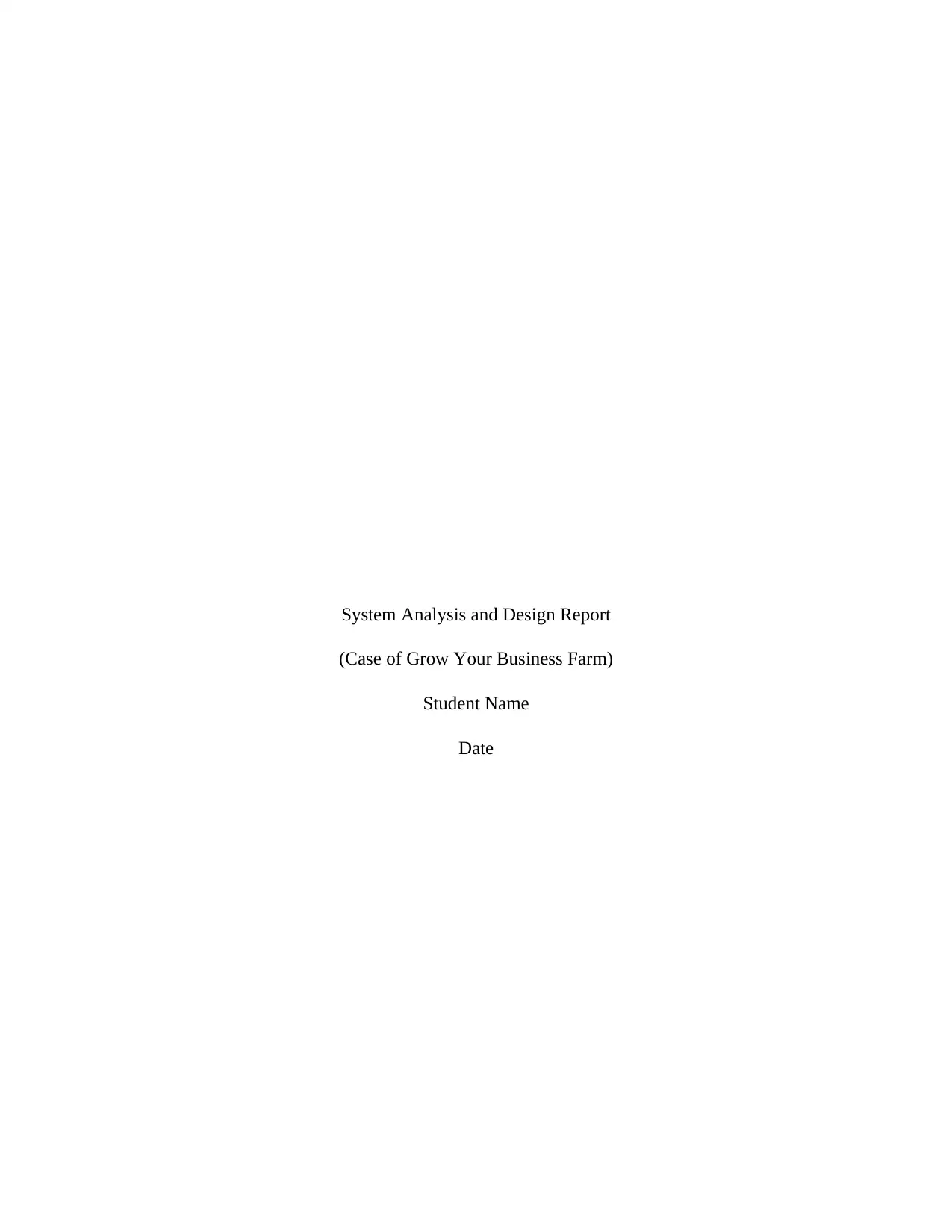
System Analysis and Design Report
(Case of Grow Your Business Farm)
Student Name
Date
(Case of Grow Your Business Farm)
Student Name
Date
Paraphrase This Document
Need a fresh take? Get an instant paraphrase of this document with our AI Paraphraser
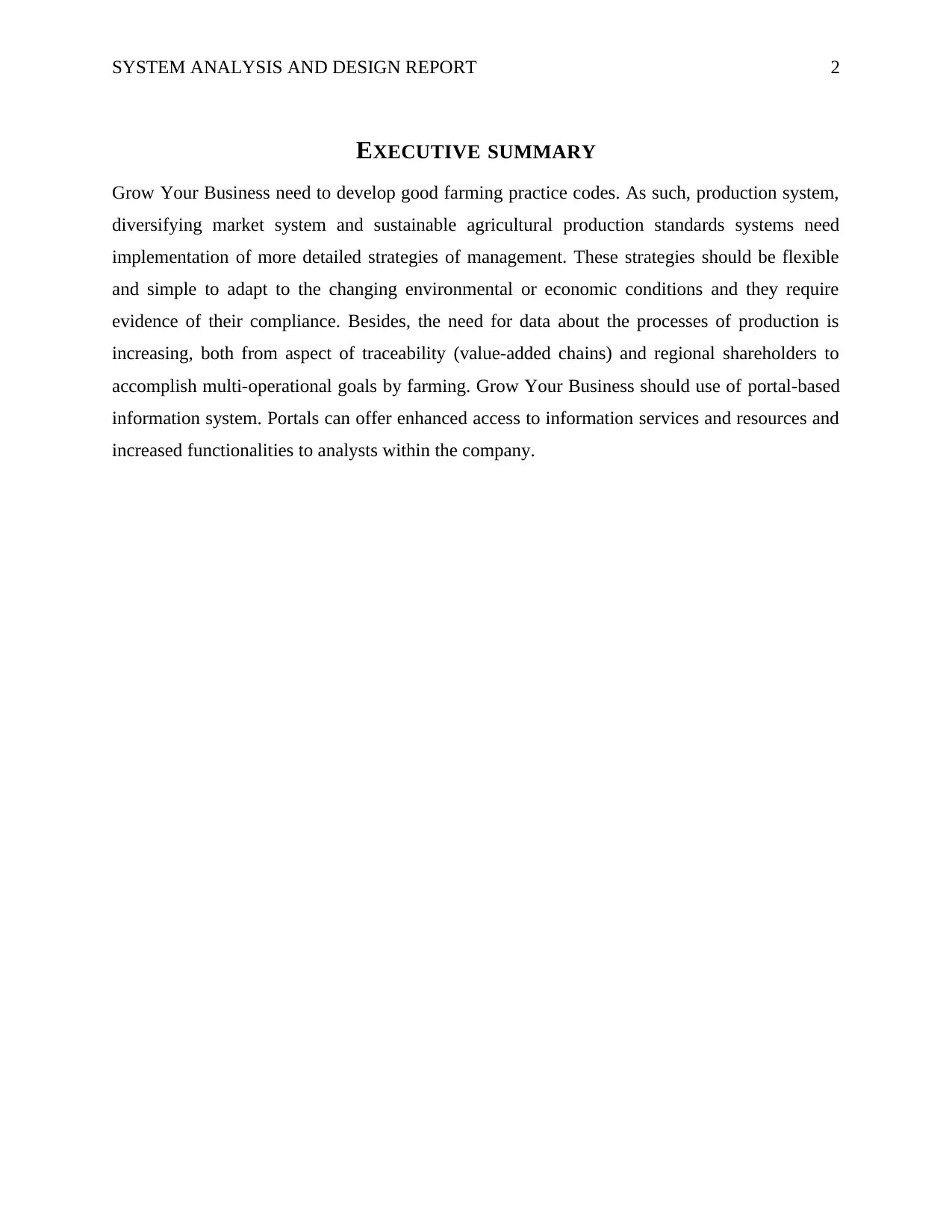
SYSTEM ANALYSIS AND DESIGN REPORT 2
EXECUTIVE SUMMARY
Grow Your Business need to develop good farming practice codes. As such, production system,
diversifying market system and sustainable agricultural production standards systems need
implementation of more detailed strategies of management. These strategies should be flexible
and simple to adapt to the changing environmental or economic conditions and they require
evidence of their compliance. Besides, the need for data about the processes of production is
increasing, both from aspect of traceability (value-added chains) and regional shareholders to
accomplish multi-operational goals by farming. Grow Your Business should use of portal-based
information system. Portals can offer enhanced access to information services and resources and
increased functionalities to analysts within the company.
EXECUTIVE SUMMARY
Grow Your Business need to develop good farming practice codes. As such, production system,
diversifying market system and sustainable agricultural production standards systems need
implementation of more detailed strategies of management. These strategies should be flexible
and simple to adapt to the changing environmental or economic conditions and they require
evidence of their compliance. Besides, the need for data about the processes of production is
increasing, both from aspect of traceability (value-added chains) and regional shareholders to
accomplish multi-operational goals by farming. Grow Your Business should use of portal-based
information system. Portals can offer enhanced access to information services and resources and
increased functionalities to analysts within the company.
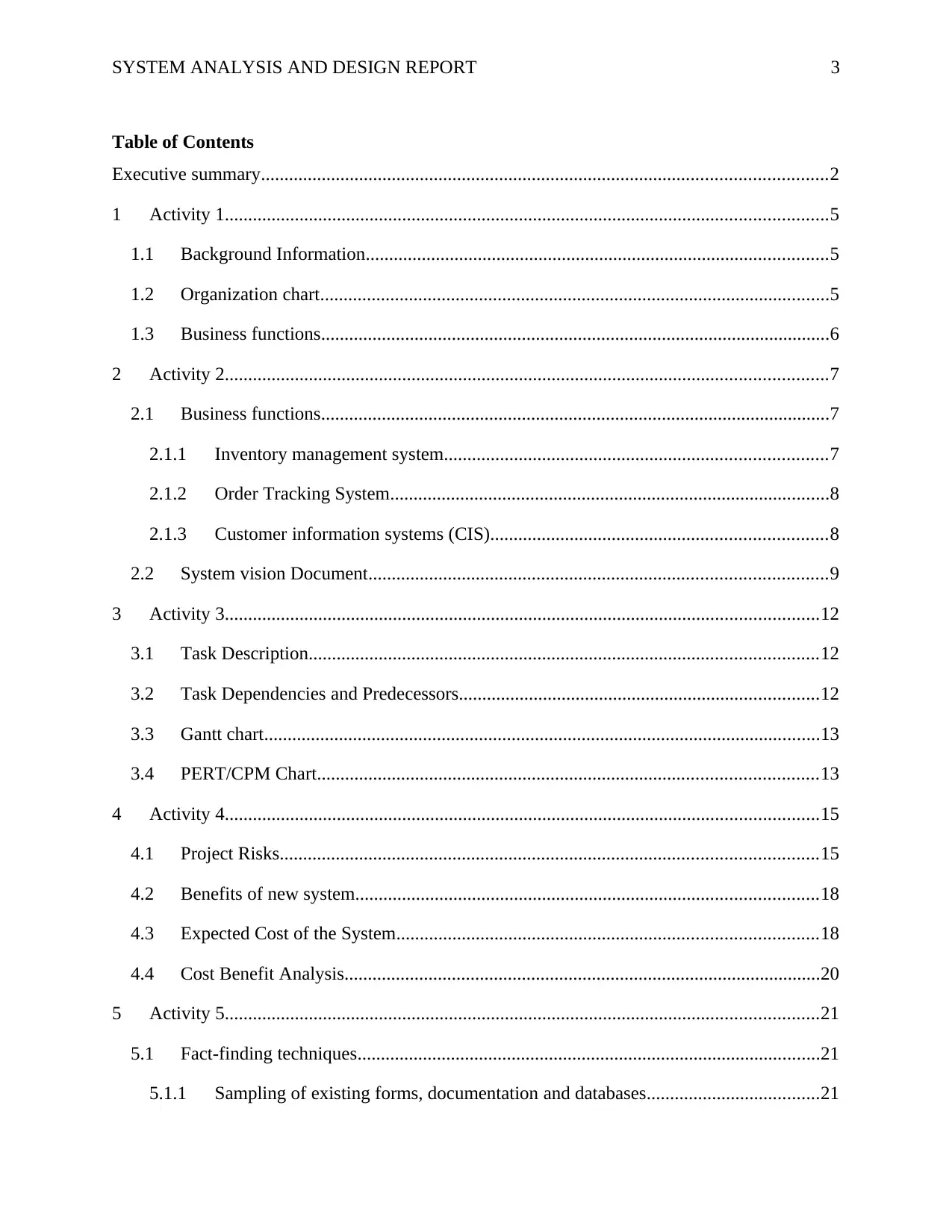
SYSTEM ANALYSIS AND DESIGN REPORT 3
Table of Contents
Executive summary.........................................................................................................................2
1 Activity 1.................................................................................................................................5
1.1 Background Information...................................................................................................5
1.2 Organization chart.............................................................................................................5
1.3 Business functions.............................................................................................................6
2 Activity 2.................................................................................................................................7
2.1 Business functions.............................................................................................................7
2.1.1 Inventory management system..................................................................................7
2.1.2 Order Tracking System..............................................................................................8
2.1.3 Customer information systems (CIS)........................................................................8
2.2 System vision Document..................................................................................................9
3 Activity 3...............................................................................................................................12
3.1 Task Description.............................................................................................................12
3.2 Task Dependencies and Predecessors.............................................................................12
3.3 Gantt chart.......................................................................................................................13
3.4 PERT/CPM Chart...........................................................................................................13
4 Activity 4...............................................................................................................................15
4.1 Project Risks...................................................................................................................15
4.2 Benefits of new system...................................................................................................18
4.3 Expected Cost of the System..........................................................................................18
4.4 Cost Benefit Analysis......................................................................................................20
5 Activity 5...............................................................................................................................21
5.1 Fact-finding techniques...................................................................................................21
5.1.1 Sampling of existing forms, documentation and databases.....................................21
Table of Contents
Executive summary.........................................................................................................................2
1 Activity 1.................................................................................................................................5
1.1 Background Information...................................................................................................5
1.2 Organization chart.............................................................................................................5
1.3 Business functions.............................................................................................................6
2 Activity 2.................................................................................................................................7
2.1 Business functions.............................................................................................................7
2.1.1 Inventory management system..................................................................................7
2.1.2 Order Tracking System..............................................................................................8
2.1.3 Customer information systems (CIS)........................................................................8
2.2 System vision Document..................................................................................................9
3 Activity 3...............................................................................................................................12
3.1 Task Description.............................................................................................................12
3.2 Task Dependencies and Predecessors.............................................................................12
3.3 Gantt chart.......................................................................................................................13
3.4 PERT/CPM Chart...........................................................................................................13
4 Activity 4...............................................................................................................................15
4.1 Project Risks...................................................................................................................15
4.2 Benefits of new system...................................................................................................18
4.3 Expected Cost of the System..........................................................................................18
4.4 Cost Benefit Analysis......................................................................................................20
5 Activity 5...............................................................................................................................21
5.1 Fact-finding techniques...................................................................................................21
5.1.1 Sampling of existing forms, documentation and databases.....................................21
⊘ This is a preview!⊘
Do you want full access?
Subscribe today to unlock all pages.

Trusted by 1+ million students worldwide
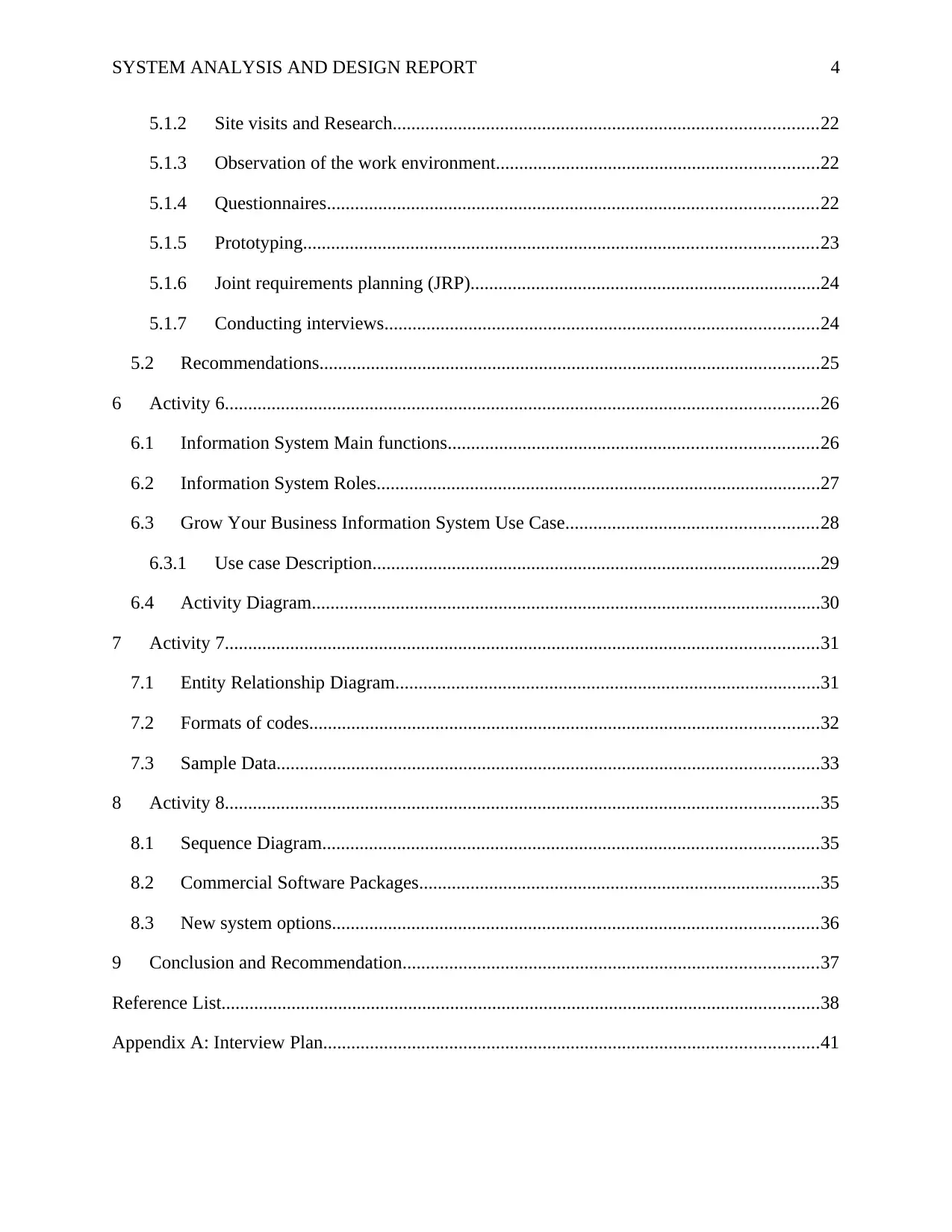
SYSTEM ANALYSIS AND DESIGN REPORT 4
5.1.2 Site visits and Research...........................................................................................22
5.1.3 Observation of the work environment.....................................................................22
5.1.4 Questionnaires.........................................................................................................22
5.1.5 Prototyping..............................................................................................................23
5.1.6 Joint requirements planning (JRP)...........................................................................24
5.1.7 Conducting interviews.............................................................................................24
5.2 Recommendations...........................................................................................................25
6 Activity 6...............................................................................................................................26
6.1 Information System Main functions...............................................................................26
6.2 Information System Roles...............................................................................................27
6.3 Grow Your Business Information System Use Case......................................................28
6.3.1 Use case Description................................................................................................29
6.4 Activity Diagram.............................................................................................................30
7 Activity 7...............................................................................................................................31
7.1 Entity Relationship Diagram...........................................................................................31
7.2 Formats of codes.............................................................................................................32
7.3 Sample Data....................................................................................................................33
8 Activity 8...............................................................................................................................35
8.1 Sequence Diagram..........................................................................................................35
8.2 Commercial Software Packages......................................................................................35
8.3 New system options........................................................................................................36
9 Conclusion and Recommendation.........................................................................................37
Reference List................................................................................................................................38
Appendix A: Interview Plan..........................................................................................................41
5.1.2 Site visits and Research...........................................................................................22
5.1.3 Observation of the work environment.....................................................................22
5.1.4 Questionnaires.........................................................................................................22
5.1.5 Prototyping..............................................................................................................23
5.1.6 Joint requirements planning (JRP)...........................................................................24
5.1.7 Conducting interviews.............................................................................................24
5.2 Recommendations...........................................................................................................25
6 Activity 6...............................................................................................................................26
6.1 Information System Main functions...............................................................................26
6.2 Information System Roles...............................................................................................27
6.3 Grow Your Business Information System Use Case......................................................28
6.3.1 Use case Description................................................................................................29
6.4 Activity Diagram.............................................................................................................30
7 Activity 7...............................................................................................................................31
7.1 Entity Relationship Diagram...........................................................................................31
7.2 Formats of codes.............................................................................................................32
7.3 Sample Data....................................................................................................................33
8 Activity 8...............................................................................................................................35
8.1 Sequence Diagram..........................................................................................................35
8.2 Commercial Software Packages......................................................................................35
8.3 New system options........................................................................................................36
9 Conclusion and Recommendation.........................................................................................37
Reference List................................................................................................................................38
Appendix A: Interview Plan..........................................................................................................41
Paraphrase This Document
Need a fresh take? Get an instant paraphrase of this document with our AI Paraphraser
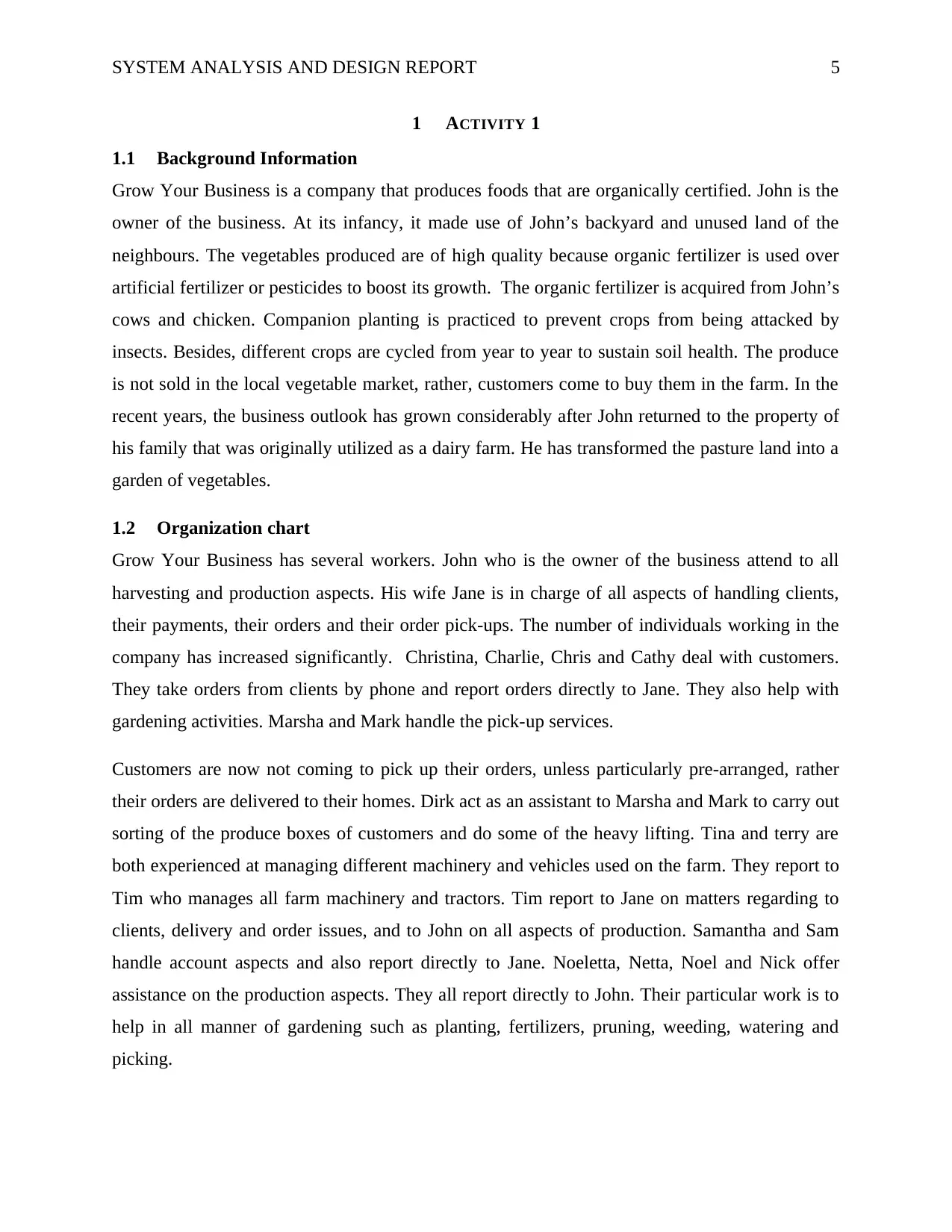
SYSTEM ANALYSIS AND DESIGN REPORT 5
1 ACTIVITY 1
1.1 Background Information
Grow Your Business is a company that produces foods that are organically certified. John is the
owner of the business. At its infancy, it made use of John’s backyard and unused land of the
neighbours. The vegetables produced are of high quality because organic fertilizer is used over
artificial fertilizer or pesticides to boost its growth. The organic fertilizer is acquired from John’s
cows and chicken. Companion planting is practiced to prevent crops from being attacked by
insects. Besides, different crops are cycled from year to year to sustain soil health. The produce
is not sold in the local vegetable market, rather, customers come to buy them in the farm. In the
recent years, the business outlook has grown considerably after John returned to the property of
his family that was originally utilized as a dairy farm. He has transformed the pasture land into a
garden of vegetables.
1.2 Organization chart
Grow Your Business has several workers. John who is the owner of the business attend to all
harvesting and production aspects. His wife Jane is in charge of all aspects of handling clients,
their payments, their orders and their order pick-ups. The number of individuals working in the
company has increased significantly. Christina, Charlie, Chris and Cathy deal with customers.
They take orders from clients by phone and report orders directly to Jane. They also help with
gardening activities. Marsha and Mark handle the pick-up services.
Customers are now not coming to pick up their orders, unless particularly pre-arranged, rather
their orders are delivered to their homes. Dirk act as an assistant to Marsha and Mark to carry out
sorting of the produce boxes of customers and do some of the heavy lifting. Tina and terry are
both experienced at managing different machinery and vehicles used on the farm. They report to
Tim who manages all farm machinery and tractors. Tim report to Jane on matters regarding to
clients, delivery and order issues, and to John on all aspects of production. Samantha and Sam
handle account aspects and also report directly to Jane. Noeletta, Netta, Noel and Nick offer
assistance on the production aspects. They all report directly to John. Their particular work is to
help in all manner of gardening such as planting, fertilizers, pruning, weeding, watering and
picking.
1 ACTIVITY 1
1.1 Background Information
Grow Your Business is a company that produces foods that are organically certified. John is the
owner of the business. At its infancy, it made use of John’s backyard and unused land of the
neighbours. The vegetables produced are of high quality because organic fertilizer is used over
artificial fertilizer or pesticides to boost its growth. The organic fertilizer is acquired from John’s
cows and chicken. Companion planting is practiced to prevent crops from being attacked by
insects. Besides, different crops are cycled from year to year to sustain soil health. The produce
is not sold in the local vegetable market, rather, customers come to buy them in the farm. In the
recent years, the business outlook has grown considerably after John returned to the property of
his family that was originally utilized as a dairy farm. He has transformed the pasture land into a
garden of vegetables.
1.2 Organization chart
Grow Your Business has several workers. John who is the owner of the business attend to all
harvesting and production aspects. His wife Jane is in charge of all aspects of handling clients,
their payments, their orders and their order pick-ups. The number of individuals working in the
company has increased significantly. Christina, Charlie, Chris and Cathy deal with customers.
They take orders from clients by phone and report orders directly to Jane. They also help with
gardening activities. Marsha and Mark handle the pick-up services.
Customers are now not coming to pick up their orders, unless particularly pre-arranged, rather
their orders are delivered to their homes. Dirk act as an assistant to Marsha and Mark to carry out
sorting of the produce boxes of customers and do some of the heavy lifting. Tina and terry are
both experienced at managing different machinery and vehicles used on the farm. They report to
Tim who manages all farm machinery and tractors. Tim report to Jane on matters regarding to
clients, delivery and order issues, and to John on all aspects of production. Samantha and Sam
handle account aspects and also report directly to Jane. Noeletta, Netta, Noel and Nick offer
assistance on the production aspects. They all report directly to John. Their particular work is to
help in all manner of gardening such as planting, fertilizers, pruning, weeding, watering and
picking.
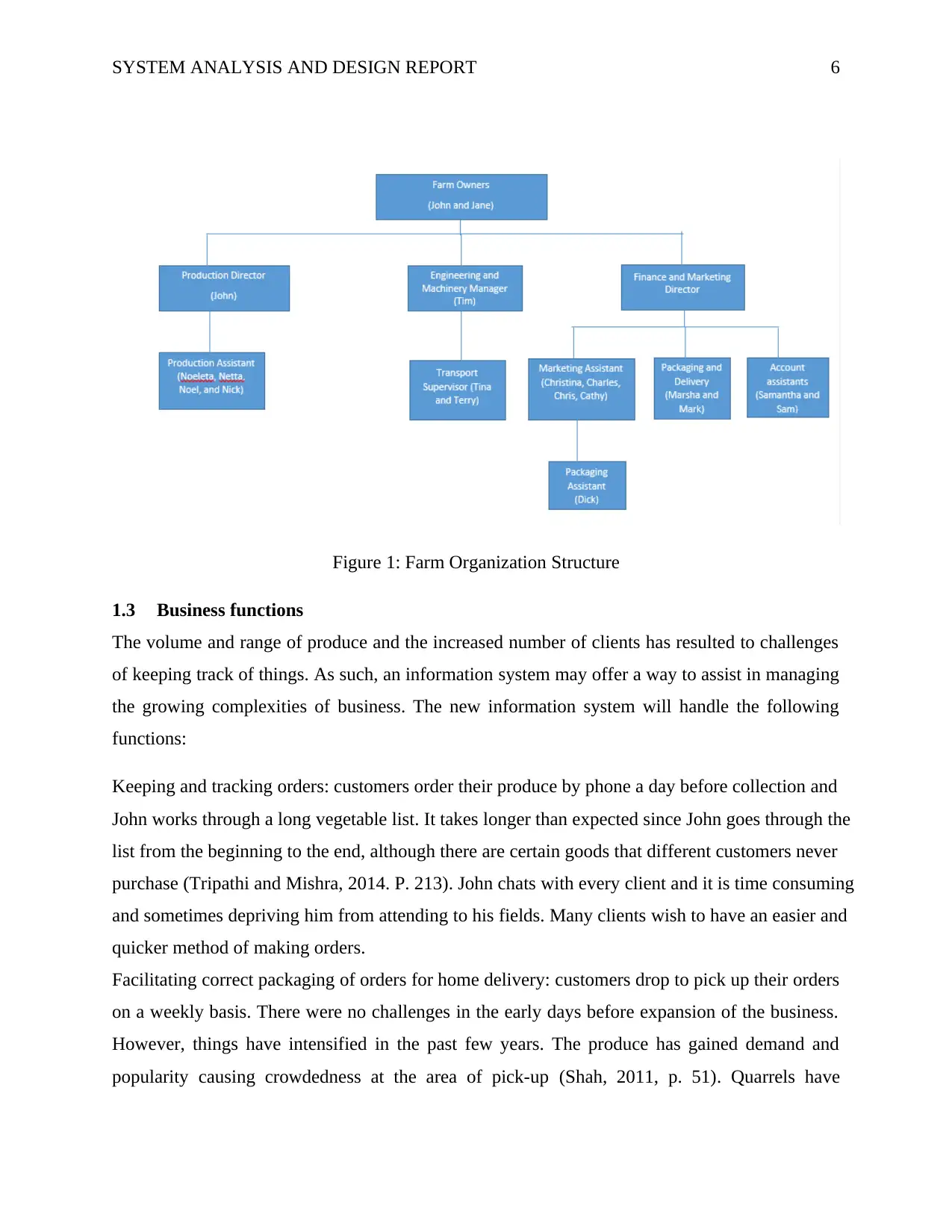
SYSTEM ANALYSIS AND DESIGN REPORT 6
Figure 1: Farm Organization Structure
1.3 Business functions
The volume and range of produce and the increased number of clients has resulted to challenges
of keeping track of things. As such, an information system may offer a way to assist in managing
the growing complexities of business. The new information system will handle the following
functions:
Keeping and tracking orders: customers order their produce by phone a day before collection and
John works through a long vegetable list. It takes longer than expected since John goes through the
list from the beginning to the end, although there are certain goods that different customers never
purchase (Tripathi and Mishra, 2014. P. 213). John chats with every client and it is time consuming
and sometimes depriving him from attending to his fields. Many clients wish to have an easier and
quicker method of making orders.
Facilitating correct packaging of orders for home delivery: customers drop to pick up their orders
on a weekly basis. There were no challenges in the early days before expansion of the business.
However, things have intensified in the past few years. The produce has gained demand and
popularity causing crowdedness at the area of pick-up (Shah, 2011, p. 51). Quarrels have
Figure 1: Farm Organization Structure
1.3 Business functions
The volume and range of produce and the increased number of clients has resulted to challenges
of keeping track of things. As such, an information system may offer a way to assist in managing
the growing complexities of business. The new information system will handle the following
functions:
Keeping and tracking orders: customers order their produce by phone a day before collection and
John works through a long vegetable list. It takes longer than expected since John goes through the
list from the beginning to the end, although there are certain goods that different customers never
purchase (Tripathi and Mishra, 2014. P. 213). John chats with every client and it is time consuming
and sometimes depriving him from attending to his fields. Many clients wish to have an easier and
quicker method of making orders.
Facilitating correct packaging of orders for home delivery: customers drop to pick up their orders
on a weekly basis. There were no challenges in the early days before expansion of the business.
However, things have intensified in the past few years. The produce has gained demand and
popularity causing crowdedness at the area of pick-up (Shah, 2011, p. 51). Quarrels have
⊘ This is a preview!⊘
Do you want full access?
Subscribe today to unlock all pages.

Trusted by 1+ million students worldwide
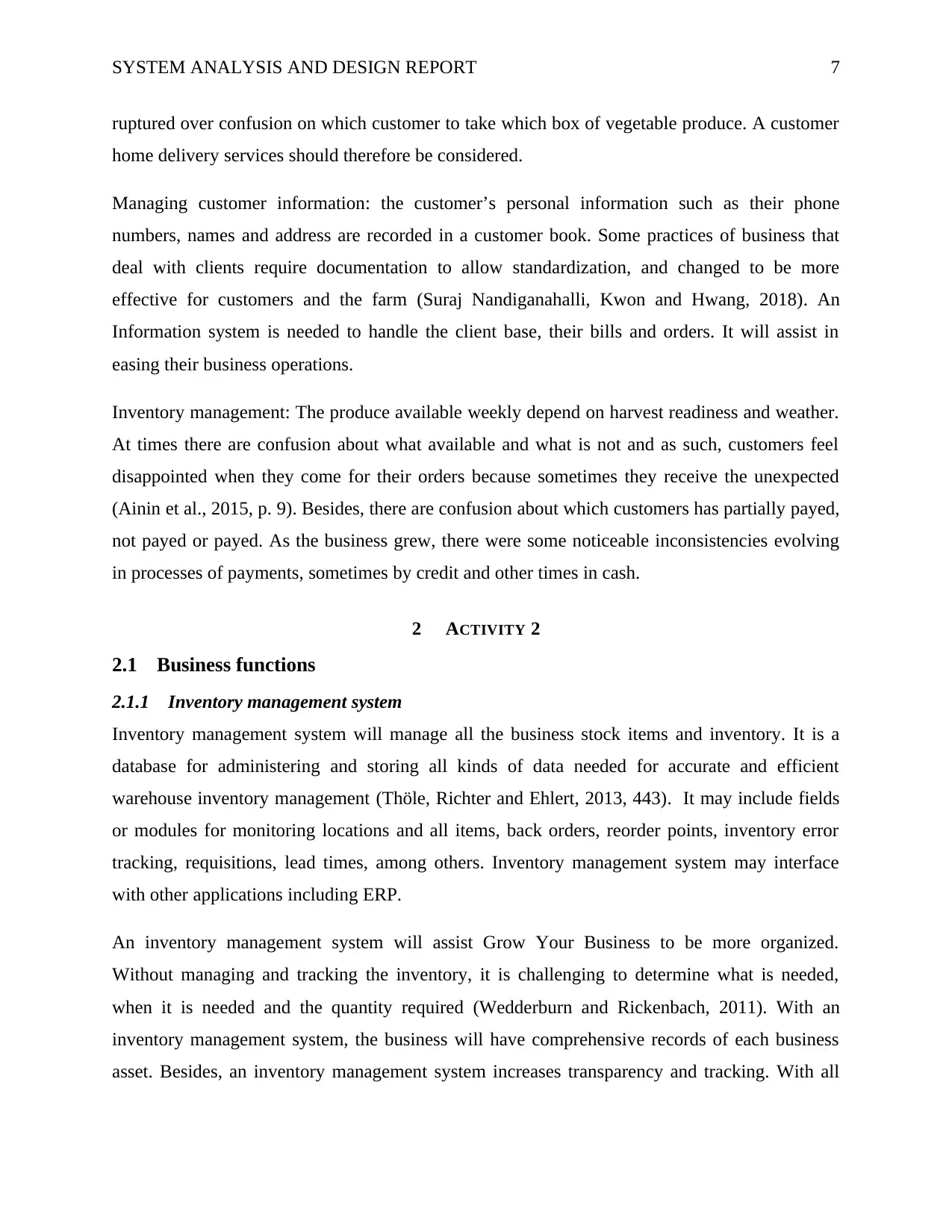
SYSTEM ANALYSIS AND DESIGN REPORT 7
ruptured over confusion on which customer to take which box of vegetable produce. A customer
home delivery services should therefore be considered.
Managing customer information: the customer’s personal information such as their phone
numbers, names and address are recorded in a customer book. Some practices of business that
deal with clients require documentation to allow standardization, and changed to be more
effective for customers and the farm (Suraj Nandiganahalli, Kwon and Hwang, 2018). An
Information system is needed to handle the client base, their bills and orders. It will assist in
easing their business operations.
Inventory management: The produce available weekly depend on harvest readiness and weather.
At times there are confusion about what available and what is not and as such, customers feel
disappointed when they come for their orders because sometimes they receive the unexpected
(Ainin et al., 2015, p. 9). Besides, there are confusion about which customers has partially payed,
not payed or payed. As the business grew, there were some noticeable inconsistencies evolving
in processes of payments, sometimes by credit and other times in cash.
2 ACTIVITY 2
2.1 Business functions
2.1.1 Inventory management system
Inventory management system will manage all the business stock items and inventory. It is a
database for administering and storing all kinds of data needed for accurate and efficient
warehouse inventory management (Thöle, Richter and Ehlert, 2013, 443). It may include fields
or modules for monitoring locations and all items, back orders, reorder points, inventory error
tracking, requisitions, lead times, among others. Inventory management system may interface
with other applications including ERP.
An inventory management system will assist Grow Your Business to be more organized.
Without managing and tracking the inventory, it is challenging to determine what is needed,
when it is needed and the quantity required (Wedderburn and Rickenbach, 2011). With an
inventory management system, the business will have comprehensive records of each business
asset. Besides, an inventory management system increases transparency and tracking. With all
ruptured over confusion on which customer to take which box of vegetable produce. A customer
home delivery services should therefore be considered.
Managing customer information: the customer’s personal information such as their phone
numbers, names and address are recorded in a customer book. Some practices of business that
deal with clients require documentation to allow standardization, and changed to be more
effective for customers and the farm (Suraj Nandiganahalli, Kwon and Hwang, 2018). An
Information system is needed to handle the client base, their bills and orders. It will assist in
easing their business operations.
Inventory management: The produce available weekly depend on harvest readiness and weather.
At times there are confusion about what available and what is not and as such, customers feel
disappointed when they come for their orders because sometimes they receive the unexpected
(Ainin et al., 2015, p. 9). Besides, there are confusion about which customers has partially payed,
not payed or payed. As the business grew, there were some noticeable inconsistencies evolving
in processes of payments, sometimes by credit and other times in cash.
2 ACTIVITY 2
2.1 Business functions
2.1.1 Inventory management system
Inventory management system will manage all the business stock items and inventory. It is a
database for administering and storing all kinds of data needed for accurate and efficient
warehouse inventory management (Thöle, Richter and Ehlert, 2013, 443). It may include fields
or modules for monitoring locations and all items, back orders, reorder points, inventory error
tracking, requisitions, lead times, among others. Inventory management system may interface
with other applications including ERP.
An inventory management system will assist Grow Your Business to be more organized.
Without managing and tracking the inventory, it is challenging to determine what is needed,
when it is needed and the quantity required (Wedderburn and Rickenbach, 2011). With an
inventory management system, the business will have comprehensive records of each business
asset. Besides, an inventory management system increases transparency and tracking. With all
Paraphrase This Document
Need a fresh take? Get an instant paraphrase of this document with our AI Paraphraser
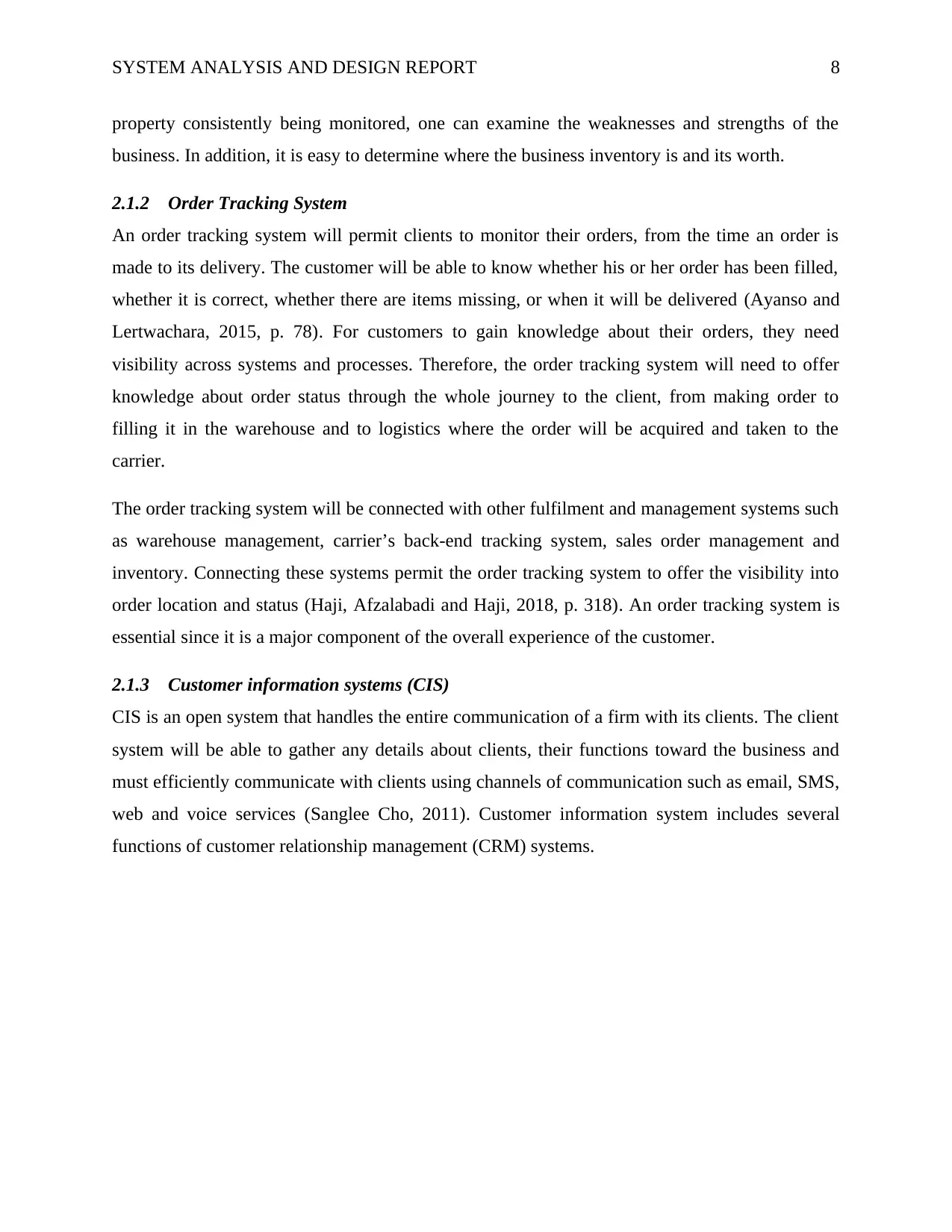
SYSTEM ANALYSIS AND DESIGN REPORT 8
property consistently being monitored, one can examine the weaknesses and strengths of the
business. In addition, it is easy to determine where the business inventory is and its worth.
2.1.2 Order Tracking System
An order tracking system will permit clients to monitor their orders, from the time an order is
made to its delivery. The customer will be able to know whether his or her order has been filled,
whether it is correct, whether there are items missing, or when it will be delivered (Ayanso and
Lertwachara, 2015, p. 78). For customers to gain knowledge about their orders, they need
visibility across systems and processes. Therefore, the order tracking system will need to offer
knowledge about order status through the whole journey to the client, from making order to
filling it in the warehouse and to logistics where the order will be acquired and taken to the
carrier.
The order tracking system will be connected with other fulfilment and management systems such
as warehouse management, carrier’s back-end tracking system, sales order management and
inventory. Connecting these systems permit the order tracking system to offer the visibility into
order location and status (Haji, Afzalabadi and Haji, 2018, p. 318). An order tracking system is
essential since it is a major component of the overall experience of the customer.
2.1.3 Customer information systems (CIS)
CIS is an open system that handles the entire communication of a firm with its clients. The client
system will be able to gather any details about clients, their functions toward the business and
must efficiently communicate with clients using channels of communication such as email, SMS,
web and voice services (Sanglee Cho, 2011). Customer information system includes several
functions of customer relationship management (CRM) systems.
property consistently being monitored, one can examine the weaknesses and strengths of the
business. In addition, it is easy to determine where the business inventory is and its worth.
2.1.2 Order Tracking System
An order tracking system will permit clients to monitor their orders, from the time an order is
made to its delivery. The customer will be able to know whether his or her order has been filled,
whether it is correct, whether there are items missing, or when it will be delivered (Ayanso and
Lertwachara, 2015, p. 78). For customers to gain knowledge about their orders, they need
visibility across systems and processes. Therefore, the order tracking system will need to offer
knowledge about order status through the whole journey to the client, from making order to
filling it in the warehouse and to logistics where the order will be acquired and taken to the
carrier.
The order tracking system will be connected with other fulfilment and management systems such
as warehouse management, carrier’s back-end tracking system, sales order management and
inventory. Connecting these systems permit the order tracking system to offer the visibility into
order location and status (Haji, Afzalabadi and Haji, 2018, p. 318). An order tracking system is
essential since it is a major component of the overall experience of the customer.
2.1.3 Customer information systems (CIS)
CIS is an open system that handles the entire communication of a firm with its clients. The client
system will be able to gather any details about clients, their functions toward the business and
must efficiently communicate with clients using channels of communication such as email, SMS,
web and voice services (Sanglee Cho, 2011). Customer information system includes several
functions of customer relationship management (CRM) systems.
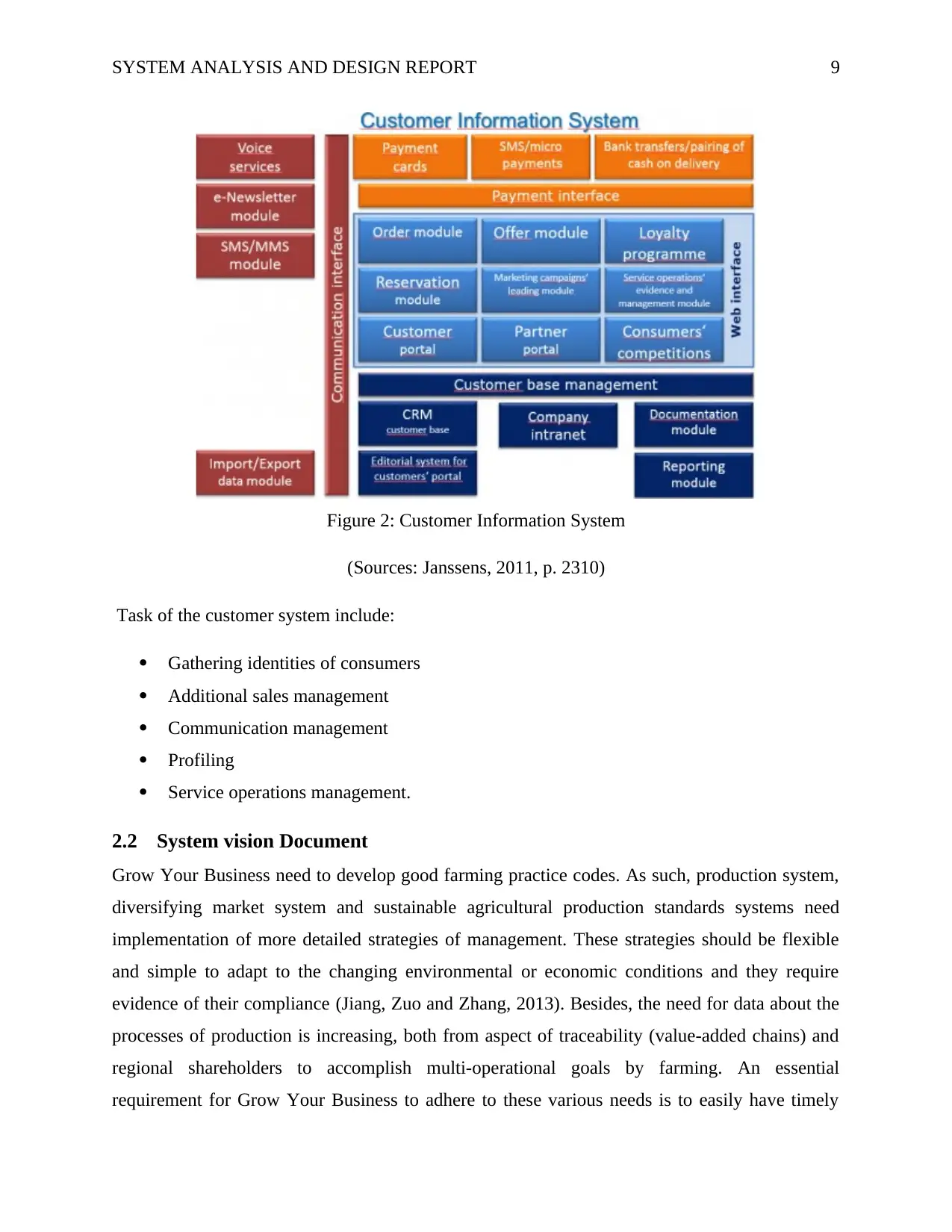
SYSTEM ANALYSIS AND DESIGN REPORT 9
Figure 2: Customer Information System
(Sources: Janssens, 2011, p. 2310)
Task of the customer system include:
Gathering identities of consumers
Additional sales management
Communication management
Profiling
Service operations management.
2.2 System vision Document
Grow Your Business need to develop good farming practice codes. As such, production system,
diversifying market system and sustainable agricultural production standards systems need
implementation of more detailed strategies of management. These strategies should be flexible
and simple to adapt to the changing environmental or economic conditions and they require
evidence of their compliance (Jiang, Zuo and Zhang, 2013). Besides, the need for data about the
processes of production is increasing, both from aspect of traceability (value-added chains) and
regional shareholders to accomplish multi-operational goals by farming. An essential
requirement for Grow Your Business to adhere to these various needs is to easily have timely
Figure 2: Customer Information System
(Sources: Janssens, 2011, p. 2310)
Task of the customer system include:
Gathering identities of consumers
Additional sales management
Communication management
Profiling
Service operations management.
2.2 System vision Document
Grow Your Business need to develop good farming practice codes. As such, production system,
diversifying market system and sustainable agricultural production standards systems need
implementation of more detailed strategies of management. These strategies should be flexible
and simple to adapt to the changing environmental or economic conditions and they require
evidence of their compliance (Jiang, Zuo and Zhang, 2013). Besides, the need for data about the
processes of production is increasing, both from aspect of traceability (value-added chains) and
regional shareholders to accomplish multi-operational goals by farming. An essential
requirement for Grow Your Business to adhere to these various needs is to easily have timely
⊘ This is a preview!⊘
Do you want full access?
Subscribe today to unlock all pages.

Trusted by 1+ million students worldwide
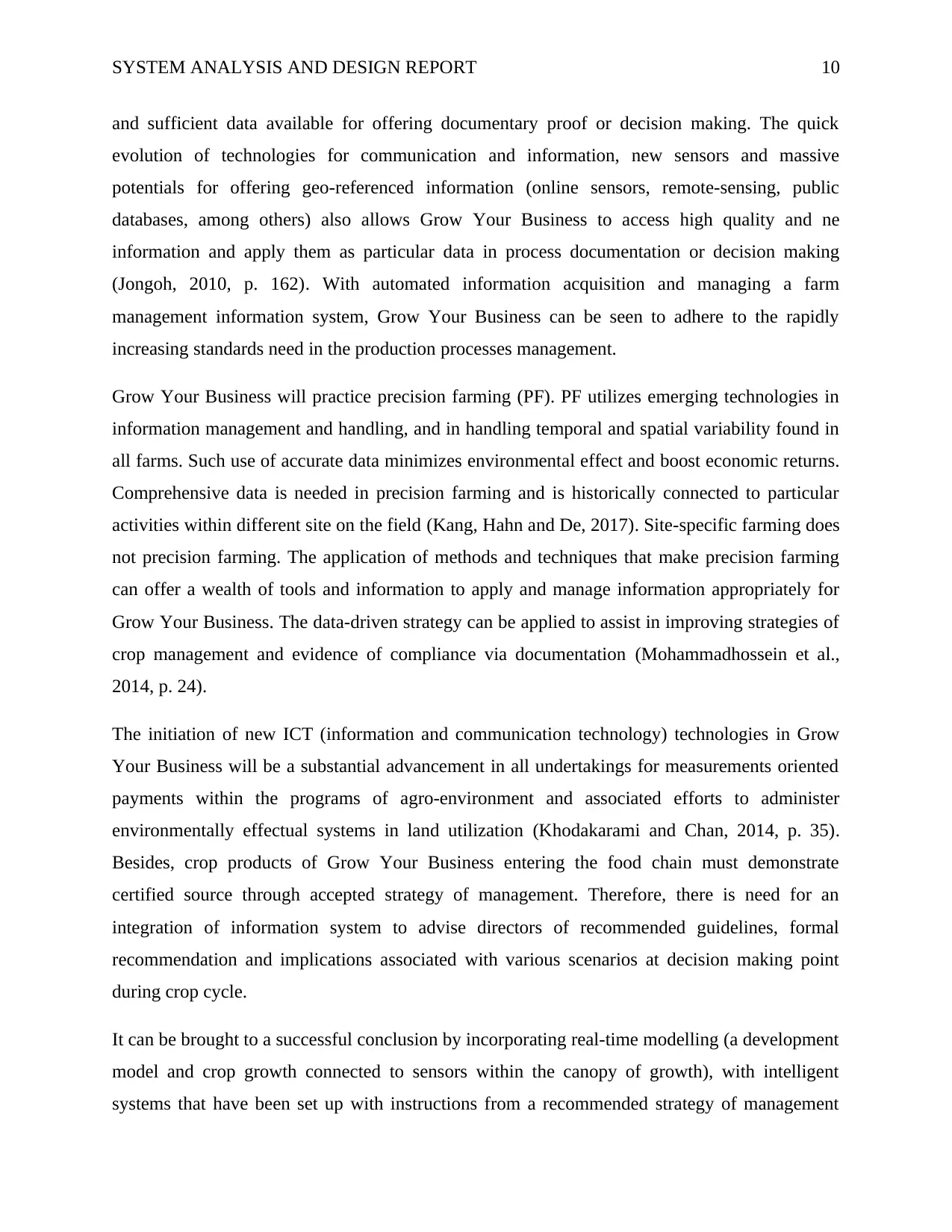
SYSTEM ANALYSIS AND DESIGN REPORT 10
and sufficient data available for offering documentary proof or decision making. The quick
evolution of technologies for communication and information, new sensors and massive
potentials for offering geo-referenced information (online sensors, remote-sensing, public
databases, among others) also allows Grow Your Business to access high quality and ne
information and apply them as particular data in process documentation or decision making
(Jongoh, 2010, p. 162). With automated information acquisition and managing a farm
management information system, Grow Your Business can be seen to adhere to the rapidly
increasing standards need in the production processes management.
Grow Your Business will practice precision farming (PF). PF utilizes emerging technologies in
information management and handling, and in handling temporal and spatial variability found in
all farms. Such use of accurate data minimizes environmental effect and boost economic returns.
Comprehensive data is needed in precision farming and is historically connected to particular
activities within different site on the field (Kang, Hahn and De, 2017). Site-specific farming does
not precision farming. The application of methods and techniques that make precision farming
can offer a wealth of tools and information to apply and manage information appropriately for
Grow Your Business. The data-driven strategy can be applied to assist in improving strategies of
crop management and evidence of compliance via documentation (Mohammadhossein et al.,
2014, p. 24).
The initiation of new ICT (information and communication technology) technologies in Grow
Your Business will be a substantial advancement in all undertakings for measurements oriented
payments within the programs of agro-environment and associated efforts to administer
environmentally effectual systems in land utilization (Khodakarami and Chan, 2014, p. 35).
Besides, crop products of Grow Your Business entering the food chain must demonstrate
certified source through accepted strategy of management. Therefore, there is need for an
integration of information system to advise directors of recommended guidelines, formal
recommendation and implications associated with various scenarios at decision making point
during crop cycle.
It can be brought to a successful conclusion by incorporating real-time modelling (a development
model and crop growth connected to sensors within the canopy of growth), with intelligent
systems that have been set up with instructions from a recommended strategy of management
and sufficient data available for offering documentary proof or decision making. The quick
evolution of technologies for communication and information, new sensors and massive
potentials for offering geo-referenced information (online sensors, remote-sensing, public
databases, among others) also allows Grow Your Business to access high quality and ne
information and apply them as particular data in process documentation or decision making
(Jongoh, 2010, p. 162). With automated information acquisition and managing a farm
management information system, Grow Your Business can be seen to adhere to the rapidly
increasing standards need in the production processes management.
Grow Your Business will practice precision farming (PF). PF utilizes emerging technologies in
information management and handling, and in handling temporal and spatial variability found in
all farms. Such use of accurate data minimizes environmental effect and boost economic returns.
Comprehensive data is needed in precision farming and is historically connected to particular
activities within different site on the field (Kang, Hahn and De, 2017). Site-specific farming does
not precision farming. The application of methods and techniques that make precision farming
can offer a wealth of tools and information to apply and manage information appropriately for
Grow Your Business. The data-driven strategy can be applied to assist in improving strategies of
crop management and evidence of compliance via documentation (Mohammadhossein et al.,
2014, p. 24).
The initiation of new ICT (information and communication technology) technologies in Grow
Your Business will be a substantial advancement in all undertakings for measurements oriented
payments within the programs of agro-environment and associated efforts to administer
environmentally effectual systems in land utilization (Khodakarami and Chan, 2014, p. 35).
Besides, crop products of Grow Your Business entering the food chain must demonstrate
certified source through accepted strategy of management. Therefore, there is need for an
integration of information system to advise directors of recommended guidelines, formal
recommendation and implications associated with various scenarios at decision making point
during crop cycle.
It can be brought to a successful conclusion by incorporating real-time modelling (a development
model and crop growth connected to sensors within the canopy of growth), with intelligent
systems that have been set up with instructions from a recommended strategy of management
Paraphrase This Document
Need a fresh take? Get an instant paraphrase of this document with our AI Paraphraser
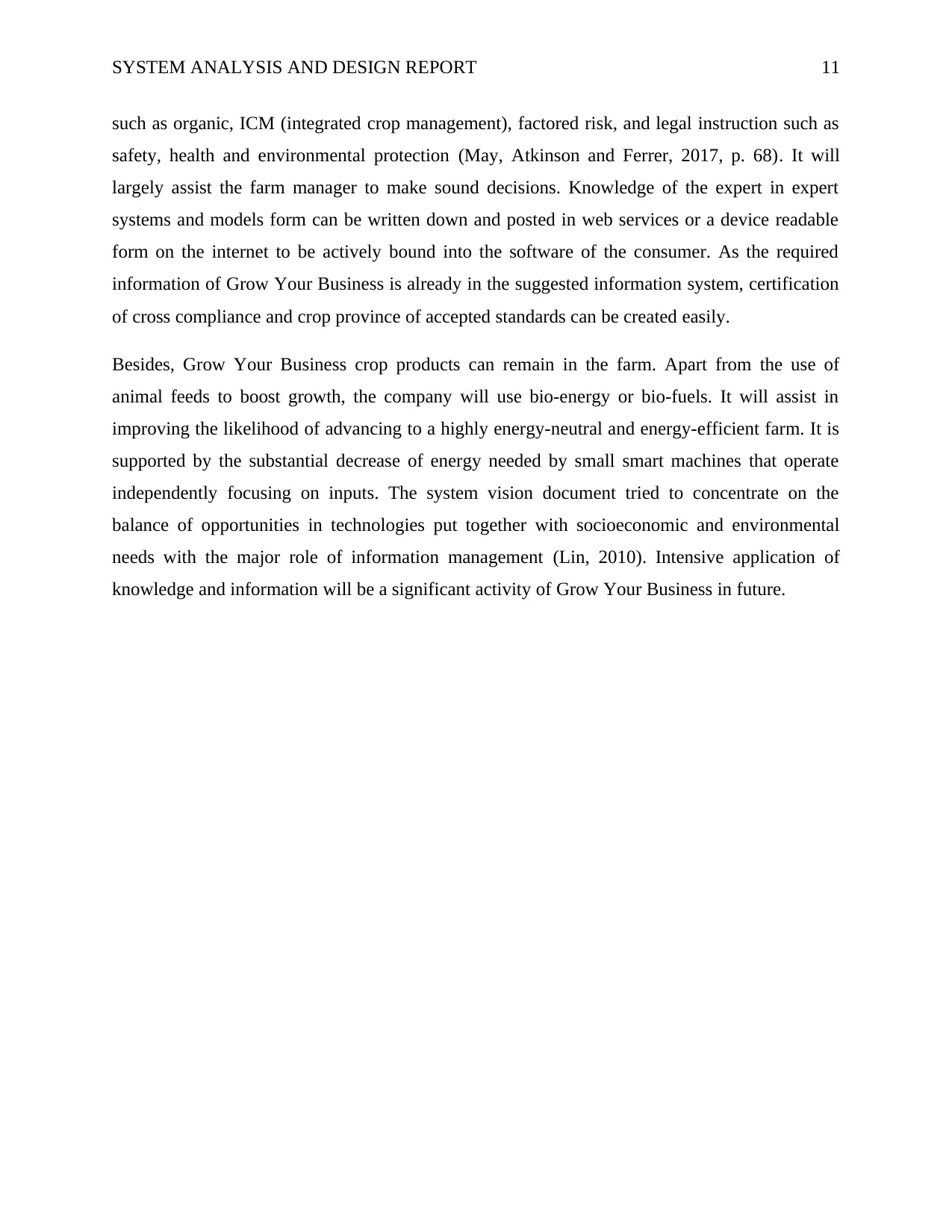
SYSTEM ANALYSIS AND DESIGN REPORT 11
such as organic, ICM (integrated crop management), factored risk, and legal instruction such as
safety, health and environmental protection (May, Atkinson and Ferrer, 2017, p. 68). It will
largely assist the farm manager to make sound decisions. Knowledge of the expert in expert
systems and models form can be written down and posted in web services or a device readable
form on the internet to be actively bound into the software of the consumer. As the required
information of Grow Your Business is already in the suggested information system, certification
of cross compliance and crop province of accepted standards can be created easily.
Besides, Grow Your Business crop products can remain in the farm. Apart from the use of
animal feeds to boost growth, the company will use bio-energy or bio-fuels. It will assist in
improving the likelihood of advancing to a highly energy-neutral and energy-efficient farm. It is
supported by the substantial decrease of energy needed by small smart machines that operate
independently focusing on inputs. The system vision document tried to concentrate on the
balance of opportunities in technologies put together with socioeconomic and environmental
needs with the major role of information management (Lin, 2010). Intensive application of
knowledge and information will be a significant activity of Grow Your Business in future.
such as organic, ICM (integrated crop management), factored risk, and legal instruction such as
safety, health and environmental protection (May, Atkinson and Ferrer, 2017, p. 68). It will
largely assist the farm manager to make sound decisions. Knowledge of the expert in expert
systems and models form can be written down and posted in web services or a device readable
form on the internet to be actively bound into the software of the consumer. As the required
information of Grow Your Business is already in the suggested information system, certification
of cross compliance and crop province of accepted standards can be created easily.
Besides, Grow Your Business crop products can remain in the farm. Apart from the use of
animal feeds to boost growth, the company will use bio-energy or bio-fuels. It will assist in
improving the likelihood of advancing to a highly energy-neutral and energy-efficient farm. It is
supported by the substantial decrease of energy needed by small smart machines that operate
independently focusing on inputs. The system vision document tried to concentrate on the
balance of opportunities in technologies put together with socioeconomic and environmental
needs with the major role of information management (Lin, 2010). Intensive application of
knowledge and information will be a significant activity of Grow Your Business in future.
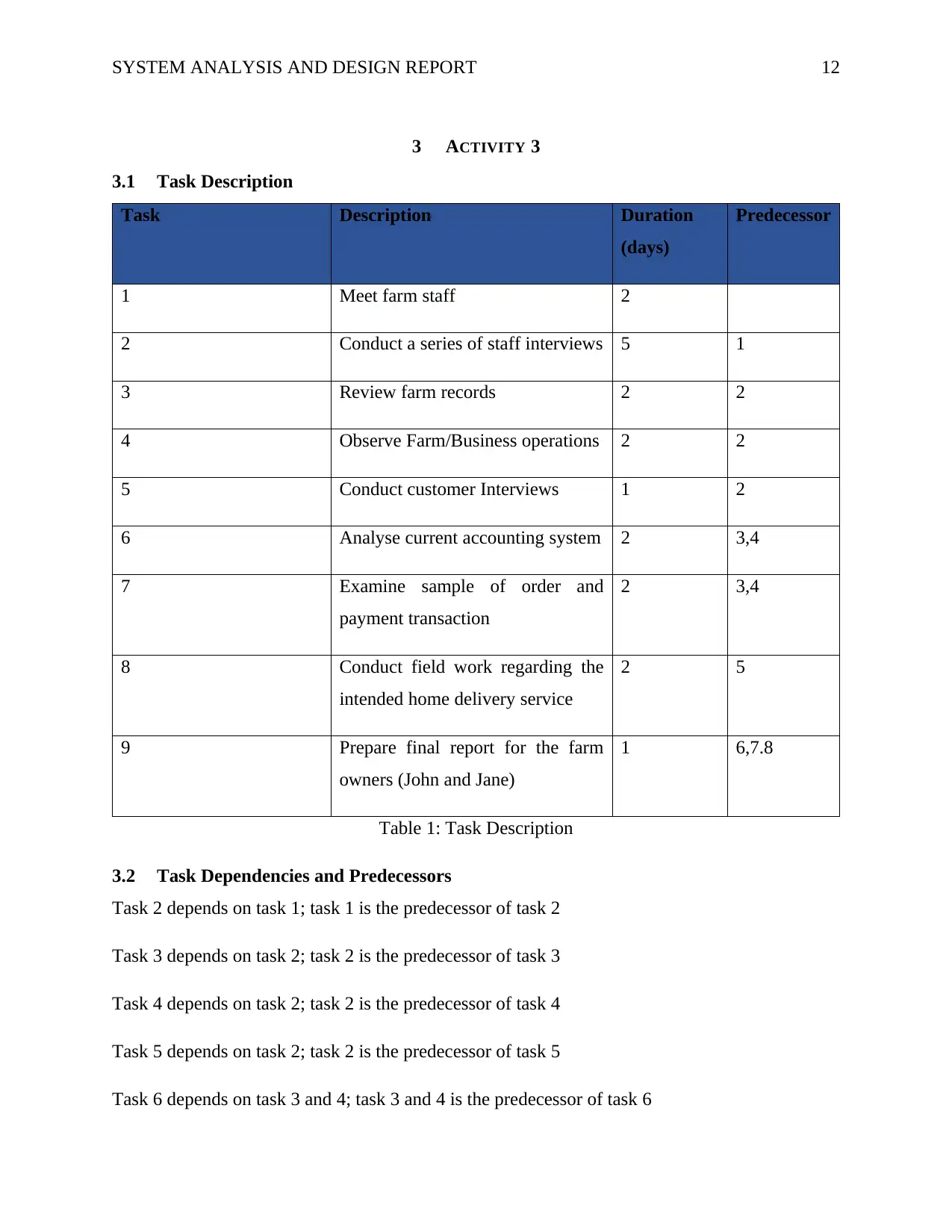
SYSTEM ANALYSIS AND DESIGN REPORT 12
3 ACTIVITY 3
3.1 Task Description
Task Description Duration
(days)
Predecessor
1 Meet farm staff 2
2 Conduct a series of staff interviews 5 1
3 Review farm records 2 2
4 Observe Farm/Business operations 2 2
5 Conduct customer Interviews 1 2
6 Analyse current accounting system 2 3,4
7 Examine sample of order and
payment transaction
2 3,4
8 Conduct field work regarding the
intended home delivery service
2 5
9 Prepare final report for the farm
owners (John and Jane)
1 6,7.8
Table 1: Task Description
3.2 Task Dependencies and Predecessors
Task 2 depends on task 1; task 1 is the predecessor of task 2
Task 3 depends on task 2; task 2 is the predecessor of task 3
Task 4 depends on task 2; task 2 is the predecessor of task 4
Task 5 depends on task 2; task 2 is the predecessor of task 5
Task 6 depends on task 3 and 4; task 3 and 4 is the predecessor of task 6
3 ACTIVITY 3
3.1 Task Description
Task Description Duration
(days)
Predecessor
1 Meet farm staff 2
2 Conduct a series of staff interviews 5 1
3 Review farm records 2 2
4 Observe Farm/Business operations 2 2
5 Conduct customer Interviews 1 2
6 Analyse current accounting system 2 3,4
7 Examine sample of order and
payment transaction
2 3,4
8 Conduct field work regarding the
intended home delivery service
2 5
9 Prepare final report for the farm
owners (John and Jane)
1 6,7.8
Table 1: Task Description
3.2 Task Dependencies and Predecessors
Task 2 depends on task 1; task 1 is the predecessor of task 2
Task 3 depends on task 2; task 2 is the predecessor of task 3
Task 4 depends on task 2; task 2 is the predecessor of task 4
Task 5 depends on task 2; task 2 is the predecessor of task 5
Task 6 depends on task 3 and 4; task 3 and 4 is the predecessor of task 6
⊘ This is a preview!⊘
Do you want full access?
Subscribe today to unlock all pages.

Trusted by 1+ million students worldwide
1 out of 42
Related Documents
Your All-in-One AI-Powered Toolkit for Academic Success.
+13062052269
info@desklib.com
Available 24*7 on WhatsApp / Email
![[object Object]](/_next/static/media/star-bottom.7253800d.svg)
Unlock your academic potential
Copyright © 2020–2025 A2Z Services. All Rights Reserved. Developed and managed by ZUCOL.
